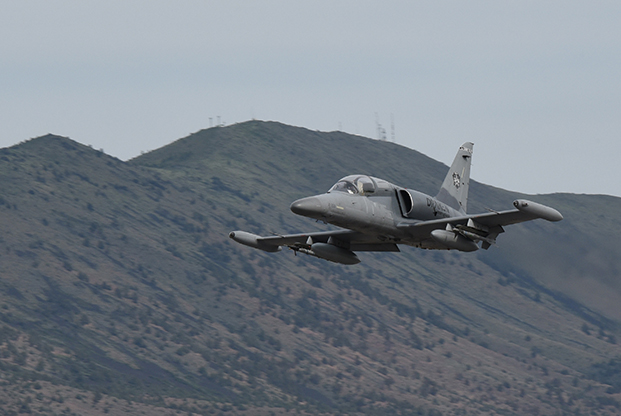A Draken International L-159E Honey Badger aircraft heads for the Oregon Test and Training Range to simulate an adversary during training missions for the 173rd Fighter Wing under a contract to test their services for future use, on June 5, 2018. Air National Guard photo by TSgt. Jefferson Thompson.
The Air Force will expand its contractor-run adversary air from one to three locations in 2020, freeing up airmen “to practice their own skills rather than spend time simulating the skills of our adversaries,” according to recently released fiscal 2020 budget documents.
Draken International is currently on contract at Nellis AFB, Nev., where they support the Air Force Weapons School and major exercises like Red Flag. But the service plans to award two more contracts in 2020, setting up a permanent presence of private adversary air at Klamath Falls Arpt/Kingsley Field, Ore., and Holloman AFB, N.M., service spokeswoman Capt. Cara Bousie told Air Force Magazine.
The awards will be part of a broader multi-award contract, known as Combat Air Force Contracted Air Support (CAF/CAS), worth up to $6 billion for 40,000-plus hours of adversary air at 12 fighter bases and nearly 10,000 hours to help train joint terminal attack controllers at nine Army bases.
Kingsley is home to the 173rd Fighter Wing, the sole formal training schoolhouse for the F-15 Eagle, while Holloman’s 54th Fighter Group—a detachment of the 56th Fighter Wing at Luke AFB, Ariz.—hosts F-16 pilot training. The Air Force is looking to fill 1,828 sorties a year at Kingsley, or about eight 1.5 hour sorties a day. At Holloman, the Air Force needs industry to provide up to 2,640 sorties a year, or between 10 to 14 1.2-hour sorties a day, according to documents published on a federal contracting website.
Draken deployed a squadron of its L-159E Honey Badgers to Kingsley for six weeks last summer for student pilot training and to “evaluate a longer term contract that may begin next summer,” the service announced at the time.
Air Force Magazine visited Draken’s facility in Lakeland, Fla., late last year and flew in an L-39. Watch the video above. Video by Amy McCullough and Mike Tsukamoto/staff.
“Typically, Kingsley’s F-15s fly the adversary air portions of training exercises, which can require up to an additional three aircraft to train a single student pilot,” the Air Force said in June 2018. “The use of the ADAIR aircraft frees up some of those aircraft and instructor pilots to fly additional students.”
In addition to the roughly 24 sorties a day Draken flies at Nellis, the company in the last year also deployed to eight of the 12 anticipated CAF/CAS operating locations, as well as Mountain Home AFB, Idaho, and the Air National Guard’s Fresno Yosemite Arpt, Calif., according to Scott Poteet, Draken’s director of Air Force programs.
The company is scheduled to deploy in support of the Guard’s Sentry Savannah exercise in April, then to Seymour Johnson AFB, N.C., in May, and Red Flag Alaska in June. In July, Draken will head back to Klamath Falls, as well as Eglin AFB and Hurlburt Field, Fla. It will help with the Guard’s Northern Lightning exercise in August, Poteet added.
“Any declaration from the USAF highlighting the path forward with regard to the CAF/CAS timeline, as well as identifying operating locations, is a positive sign,” he said. “We understand the importance of improving every aspect of combat readiness training to include an increase in capacity and capability of adversary air support.”
The Air Force won’t say who submitted proposals for the CAF/CAS contract last year, but at least three other companies besides Draken have said they submitted bids: Top Aces, Tactical Air Support, and Airborne Tactical Advantage Company.
The service has evaluated all the proposals and expects to award a contract next fiscal year, pending congressional approval of the fiscal 2020 budget. Other locations slated to eventually receive contract air include: Hill AFB, Utah; Luke AFB, Ariz.; Tucson International Arpt., Ariz.; JB Pearl Harbor-Hickam, Hawaii; Kelly Field Annex, Texas; Eglin AFB, Fla.; Seymour Johnson AFB, N.C.; and JB Langley-Eustis, Va. Tyndall AFB, Fla., also was originally on the list, but the base’s F-22s have been relocated after Hurricane Michael destroyed the base last year.
